Crop Pollination Requirements
Apple
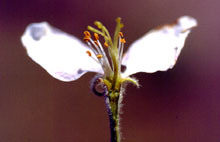 Most apple cultivars are self-sterile and require cross-pollination with another compatible cultivar. For this reason, orchardists must interplant main varieties with compatible pollenizer varieties. Generally, different strains of the same variety do not cross-pollinate each other as well as do two different varieties. It is equally important that the bloom periods of the main and pollenizer varieties overlap. To optimize pollination, plant both early- and late-blooming pollenizers so that the main variety blooms in between. That way, ample pollen will be available for the early-blooming king bloom on the main variety - the flower that produces the choicest fruit.
Most apple cultivars are self-sterile and require cross-pollination with another compatible cultivar. For this reason, orchardists must interplant main varieties with compatible pollenizer varieties. Generally, different strains of the same variety do not cross-pollinate each other as well as do two different varieties. It is equally important that the bloom periods of the main and pollenizer varieties overlap. To optimize pollination, plant both early- and late-blooming pollenizers so that the main variety blooms in between. That way, ample pollen will be available for the early-blooming king bloom on the main variety - the flower that produces the choicest fruit.
Some apple varieties have sterile pollen. These varieties accept pollen from other varieties and produce fruit, but they cannot be used as pollenizers. The table below lists cultivars, their pollen viability and relative bloom intervals.
Growers can use flowering crab apples as pollenizers instead of another commercial variety. This would be warranted if other candidate pollenizers produce inferior fruit, take up too much orchard space, have conflicting pesticide requirements or produce fruit that pickers cannot distinguish from the main variety. Crab apples can be planted in existing space between main variety trees or grafted onto them. Cut bouquets of flowering crab apples can be placed in barrels of water between rows during bloom. Make sure that the flower color of your crab varieties matches the color of the main variety since bees do not readily switch to a different colored blossom during a foraging trip. Crab apples are more susceptible to virus diseases, but whole-tree crab apple plantings, rather than grafts, reduce incidence of virus diseases.
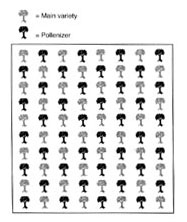 Bees prefer to work up and down rows rather than across rows. This is especially true in dense plantings and during even the lightest wind. Growers must consider this as they plan the arrangement of main and pollenizer varieties in their orchards. With plan 1, every other tree is a pollenizer (Figure 1); this maximizes the number of pollenizers, but it is practical only if there is a market for the pollenizer. All other plans compromise some degree of pollination efficiency in favor of convenience at harvest.
Bees prefer to work up and down rows rather than across rows. This is especially true in dense plantings and during even the lightest wind. Growers must consider this as they plan the arrangement of main and pollenizer varieties in their orchards. With plan 1, every other tree is a pollenizer (Figure 1); this maximizes the number of pollenizers, but it is practical only if there is a market for the pollenizer. All other plans compromise some degree of pollination efficiency in favor of convenience at harvest.
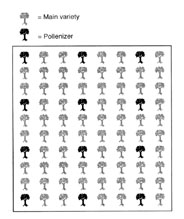 With plan 2, every third tree in every third row is a pollenizer (Figure 2); this ensures that every tree of the main variety is next to, diagonal to, or across from a pollenizer on one side. Plan 3 calls for a solid planting of the pollenizer every fourth row (Figure 3); this leaves one row of main variety by itself and is only practical if the pollenizer has market value. Plan 4 calls for two pollenizer rows next to four rows of the main variety (Figure 4); this is the least efficient design. If main and pollenizer varieties cannot withstand the same chemical regimen, do not interplant them in the same row as in plans 1 and 2. Instead, plant pollenizers in their own rows so they can be treated separately, as in plans 3 and 4. Crab apple pollenizers can be pruned for tall growth to take up little or no extra space. In this manner, they can be planted as every sixth to ninth tree in every row.
With plan 2, every third tree in every third row is a pollenizer (Figure 2); this ensures that every tree of the main variety is next to, diagonal to, or across from a pollenizer on one side. Plan 3 calls for a solid planting of the pollenizer every fourth row (Figure 3); this leaves one row of main variety by itself and is only practical if the pollenizer has market value. Plan 4 calls for two pollenizer rows next to four rows of the main variety (Figure 4); this is the least efficient design. If main and pollenizer varieties cannot withstand the same chemical regimen, do not interplant them in the same row as in plans 1 and 2. Instead, plant pollenizers in their own rows so they can be treated separately, as in plans 3 and 4. Crab apple pollenizers can be pruned for tall growth to take up little or no extra space. In this manner, they can be planted as every sixth to ninth tree in every row.


Apple Cultivars, Pollen Viability and Bloom Periods (from Horton & others, 1990)
Cultivar |
Good pollenizer interplants |
Pollen viability |
Relative bloom period |
||||||||
Winter banana |
yes |
good |
x |
x |
x |
x |
x |
x |
x |
- |
- |
Jersey Mac |
yes |
good |
x |
x |
x |
x |
x |
x |
- |
- |
- |
Empire |
- |
good |
x |
x |
x |
x |
- |
- |
- |
- |
- |
Pauland |
- |
good |
- |
x |
x |
x |
x |
- |
- |
- |
- |
Stayman |
- |
not good |
- |
x |
x |
x |
x |
- |
- |
- |
- |
Yates |
yes |
good |
- |
x |
x |
x |
x |
x |
- |
- |
- |
Jonagold |
- |
not good |
- |
- |
x |
x |
x |
x |
- |
- |
- |
Delicious |
- |
good |
- |
- |
x |
x |
x |
x |
- |
- |
- |
Braeburn |
- |
good |
- |
- |
x |
x |
x |
x |
- |
- |
- |
Mutsu |
- |
not good |
- |
- |
x |
x |
x |
x |
- |
- |
- |
Jonathan |
- |
good |
- |
- |
- |
x |
x |
x |
x |
- |
- |
Granny Smith |
- |
good |
- |
- |
- |
x |
x |
x |
x |
x |
- |
Arkansas Black |
- |
good |
- |
- |
- |
x |
x |
x |
x |
- |
- |
Gala |
- |
good |
- |
- |
- |
x |
x |
x |
x |
- |
- |
Golden Delicious |
- |
good |
- |
- |
- |
x |
x |
x |
x |
- |
- |
Fuji |
- |
good |
- |
- |
- |
x |
x |
x |
x |
x |
- |
Rome Beauty |
- |
good |
- |
- |
- |
- |
x |
x |
x |
x |
x |
Recommended Bee Populations for Apple
No. of honey bee hives/acre |
Reference |
|---|---|
| 1 | Ambrose 1990 |
| 1 | Crane & Walker 1984 |
| 2 | Mayer & others 1986 |
| 0.25, 0.5, 1, 2 | McGregor 1976 |
| 1, 2 | USDA 1986 |
| 1.2 | Literature average |
| No. of Osmia bees/acre | |
| 250 | Torchio (1985) |
Blueberry
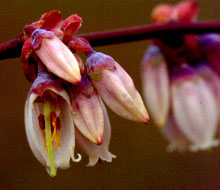 Most blueberries grown in the Southeast are one of three types: rabbiteye, southern highbush and northern highbush. Each type has numerous varieties or cultivars. Rabbiteye varieties are the most popular because they are productive, disease resistant, and adaptable throughout the region. Northern highbush ripen earlier than rabbiteye, and they are well-suited to the Piedmont and the Appalachians. Southern highbush varieties also ripen earlier than rabbiteye, but they are best suited to the southern coastal plain where soils are well-drained and hard spring frosts are rare. Cross-pollination requirements vary among the three blueberry types.
Most blueberries grown in the Southeast are one of three types: rabbiteye, southern highbush and northern highbush. Each type has numerous varieties or cultivars. Rabbiteye varieties are the most popular because they are productive, disease resistant, and adaptable throughout the region. Northern highbush ripen earlier than rabbiteye, and they are well-suited to the Piedmont and the Appalachians. Southern highbush varieties also ripen earlier than rabbiteye, but they are best suited to the southern coastal plain where soils are well-drained and hard spring frosts are rare. Cross-pollination requirements vary among the three blueberry types.
Rabbiteye varieties are almost completely self-sterile and require cross-pollination with another rabbiteye variety. One exception is the cultivar 'Centurion', which is self-fertile at least when grown in North Carolina (P. Lyrene, Univ. Florida, pers. comm.). Cross-pollination with other rabbiteye varieties improves fruit-set, size, and earliness of ripening. On a per-bee basis, Southeastern blueberry bees are the best pollinators of rabbiteye, followed by bumble bees and honey bees (Cane & Payne 1990). Carpenter bees do not pollinate rabbiteye blueberry and, in fact, reduce the effectiveness of bees that do (see the section on Carpenter Bees). By carefully selecting rabbiteye varieties for interplanting, you can prolong your harvest season and provide bloom overlap of compatible varieties for good cross-pollination. Choose varieties for interplanting with similar chill hour requirements (hours below 45 degrees F during winter) because these have the most bloom overlap. The table describes some rabbiteye varieties.
The table can help you choose rabbiteye varieties for interplanting. For example, an interplanting of 'Beckyblue', 'Bonita', and 'Woodard', having similar chill hours, promotes good bloom overlap and cross-pollination. By interplanting 'Climax', 'Bluebelle', and 'Baldwin', one can maximize both cross-pollination and length of harvest interval. Along with pollination, you must also consider fruit characteristics, flavor, and harvesting characteristics of the different varieties, so consult your county Extension agent for help in determining the best varietal blend for you.
The planting arrangement of rabbiteye blueberries is important to good cross-pollination. You want to increase the chances of a bee visiting two or more varieties during the same foraging trip. If you want equal numbers of two varieties, plant them according to Figure 5. If you want two-thirds of variety A and one-third of variety B, plant them according to Figure 6. If you want three varieties, a pattern like Figure 7 encourages good bloom overlap.
Rabbiteye Varieties (from Krewer & others 1986, 1993).
| Variety | Chill-hour Requirement |
Spring Freeze Resistant? |
|---|---|---|
Early-Season Harvest |
||
Beckyblue |
300 |
|
Bonita |
300 |
|
Brightwell |
350-400 |
yes |
Climax |
450-550 |
|
Premier |
550 |
|
Woodard |
350-400 |
|
Mid-Season Harvest |
||
Bluebelle |
450-500 |
|
Briteblue |
400-650 |
|
Powderblue |
550-650 |
yes |
Tifblue |
550-750 |
yes |
Late-Season Harvest |
||
Baldwin |
450-500 |
|
Centurion |
550-650 |
yes |
Delite |
500 |
|
Two Varieties1/2 Variety - A 1/2 Variety - B |
A |
A |
B |
B |
A |
A |
B |
B |
A |
A |
B |
B |
A |
A |
B |
B |
|
A |
A |
B |
B |
A |
A |
B |
B |
|
A |
A |
B |
B |
A |
A |
B |
B |
|
A |
A |
B |
B |
A |
A |
B |
B |
|
Figure 5. Equal numbers of two rabbiteye blueberry varieties. |
||||||||
Two Varieties 2/3 Variety - A 1/3 Variety - B |
A |
B |
A |
A |
B |
A |
A |
B |
A |
A |
B |
A |
A |
B |
A |
A |
B |
A |
|
A |
B |
A |
A |
B |
A |
A |
B |
A |
|
A |
B |
A |
A |
B |
A |
A |
B |
A |
|
A |
B |
A |
A |
B |
A |
A |
B |
A |
|
| Figure 6. Two-thirds of one rabbiteye blueberry variety and one-third of another. | |||||||||
Three Varieties 1/3 Variety - A 1/3 Variety - B 1/3 Variety - C |
A | B | C | A | B | C | A | B | C |
| A | B | C | A | B | C | A | B | C | |
| A | B | C | A | B | C | A | B | C | |
| A | B | C | A | B | C | A | B | C | |
| A | B | C | A | B | C | A | B | C | |
| Figure 7. Equal numbers of three rabbiteye blueberry varieties. | |||||||||
Northern and southern highbush varieties range from somewhat self-fertile to highly self-fertile which means they can produce fruit with their own pollen. Most varieties do not need to be interplanted with different varieties to promote cross-pollination, and these solid block plantings are convenient for managing and harvesting. However, even with highbush varieties, cross-pollination between varieties improves fruit size, seed count, and earliness of ripening, all of which are important economic considerations (Lang & Danka 1991). In Florida, the southern highbush variety 'Sharpblue' has reduced fruit set and size if it is not cross-pollinated (P. Lyrene, pers. comm.). In one study, honey bee visitation to 'Gulfcoast' variety shortened the time between pollination and harvest by five days and increased berry weight 28 percent. These effects did not depend on the type of pollen the bees were carrying (selfing with same variety, crossing with different variety, or crossing with rabbiteye variety), so this study confirms the value of honey bees as pollinators to southern highbush blueberries (Danka & others 1993).
Gibberellic acid can artificially induce fruit-set and increase yield. However, it is expensive and may reduce fruit size and delay ripening (Krewer & others 1991).
| Recommended Bee Populations for Blueberry | |
No of honey bee hives/acre |
Reference |
|---|---|
1 |
Krewer & others 1986 |
1, 5, 10 |
McGregor 1976 |
3, 4 |
USDA 1986 |
4 |
Literature average |
Bumble bees and Southeastern blueberry bees |
|
1 to 4 bees per bush |
Cane 1993 |
Cantaloupe
Cantaloupe plants have perfect flowers and imperfect, male flowers. The perfect flowers cannot self-pollinate, and the pollen is too heavy to blow in the wind, so insect pollination is necessary. Bees visit cantaloupe blossoms for both pollen and nectar, but nectar yield is low. The flowers open shortly after sunrise and close in the afternoon of the same day. The stigma is receptive to pollen for only a few hours in the morning, but in hot weather the stigma may be receptive only a few minutes. Good bee visitation in early morning is important to fruit-set.
Increasing the density of honey bee hives improves yield, weight, and sweetness of 'Primo' variety cantaloupe (Eischen & Underwood 1991).
| Recommended Bee Populations for Cantaloupe | |
No. of honey bee hives/acre |
Reference |
|---|---|
2, 3 |
Atkins & others 1979 |
3 |
Crane & Walker 1984 |
1.3, 3 |
Eischen, Underwood 1991 |
0.5, 1, 2, 3, 4, 5 |
McGregor 1976 |
1, 2 |
USDA |
2.4 |
Literature average |
Rate |
|
1 honey bee per 10 perfect flowers |
McGregor 1976 |
Cucumber
Cucumber plants ordinarily have both male and female flowers, and some agent is required to transfer pollen between flowers of the same or different plant; the only exception is some seedless varieties which produce fruit without pollination. As with other cucurbits, cucumber pollen is large and sticky, so pollination relies heavily on bees. In monoecious varieties (both male and female flowers on one plant), male flowers open about 10 days before female flowers and outnumber female flowers. These varieties are planted at a rate of 5,000-15,000 plants per acre, and harvesting the fruit stimulates the plant to produce new flowers and fruit; in this manner, several hand-harvests are possible. Gynoecious (only female flowers) varieties were developed in the interest of maximizing fruit production with one destructive, machine harvest. They are grown in dense plantings of about 50,000 to 150,000 plants per acre. Gynoecious varieties require a source of male flowers for pollen. Commercially-prepared seed is pre-mixed with around 15 percent monoecious seed to provide this pollination. With plantings of gynoecious varieties, large bee populations are doubly important to pollinate the high density of female flowers.
Cucumber is not a rich source of pollen or nectar, but bees readily visit the plants if there are no more attractive plants nearby. Bees collect pollen on cucumber mostly in early morning and switch to nectar later in the morning. In Maryland, pollen foraging is highest before 10:00 AM and decreases dramatically in the afternoon (Tew & Caron 1988). Not surprisingly, the stigma is most receptive to pollen in morning. Each stigma should receive several hundred grains of pollen for best fruit-set and quality.
In Georgia, cucumber vines screened to exclude pollinating insects produced no fruit, but open-pollinated vines set about 6.5 fruit per foot (Coleman 1979).
| Recommended Bee Populations for Cucumber | |
No. of honey bee hives/acre |
Reference |
|---|---|
2, 3 |
Atkins & others 1979 |
3 for gynoecious hybrids |
Hughes & others 1982 |
1, 2, 3; >3 for gynoecious hybrids |
McGregor 1976 |
1, 2 |
USDA 1986 |
2.1 |
Literature average |
Rate |
|
1 colony per 50,000 plants |
Hughes & others 1982 |
1 bee per 100 flowers |
McGregor 1976 |
Squash
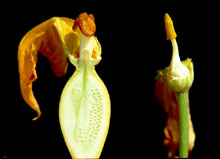 Squash plants produce separate male and female flowers. Male flowers outnumber female ones by about 3.5 to one to 10 to one. This helps ensure pollination of the female flowers which must be pollinated to set fruit. Bees are the most important pollinators, and seed number and fruit weight increase proportionally to the amount of pollen transferred to the stigma. In west Tennessee, each flower opens for only one day, usually between 5:15 and 11:00 AM (Skinner & Lovett 1992). However, if it's hot, flowers close early. Consequently, as with other cucurbits, good bee visitation in morning is important.
Squash plants produce separate male and female flowers. Male flowers outnumber female ones by about 3.5 to one to 10 to one. This helps ensure pollination of the female flowers which must be pollinated to set fruit. Bees are the most important pollinators, and seed number and fruit weight increase proportionally to the amount of pollen transferred to the stigma. In west Tennessee, each flower opens for only one day, usually between 5:15 and 11:00 AM (Skinner & Lovett 1992). However, if it's hot, flowers close early. Consequently, as with other cucurbits, good bee visitation in morning is important.
In west Tennessee (Skinner & Lovett 1992), squash plants caged to exclude pollinators produced no fruit. By bagging flowers after one bee visit, the authors found that bumble bees were more efficient than honey bees in promoting good fruit-set. However, in normal conditions with adequate bee populations, each flower is visited many times, probably by more than one bee species, and fruit-set is very good.
Bees in the genus Peponapis are excellent pollinators of squash and pumpkin. Compared to honey bees, they make more contact with reproductive parts of a flower, work faster, and work earlier in the morning. However, in spite of these desirable behaviors, Peponapis are no more efficient than honey bees at setting fruit (Tepedino 1981). Nevertheless, growers should always encourage Peponapis populations. Where Peponapis occur in high numbers, supplemental colonies of honey bees are unnecessary.
| Recommended Bee Populations for Squash | |
No. of honey bee hives/acre |
Reference |
|---|---|
1 |
Hughes & others 1982 |
0.04, 0.08, 0.5, 1, 3 |
McGregor 1976 |
1, 2 |
USDA 1986 |
1 |
Literature average |
Rate of Peponapis bees |
|
1 Peponapis per 20 flowers |
derived from Tepedino 1981 |
Watermelon
Watermelon plants have separate male and female flowers. The pollen is sticky and not blown by wind, so insect pollination is necessary to transfer pollen to receptive female stigmas. In the absence of superior food sources, bees readily visit watermelon blossoms for nectar and pollen. However, the overall density of flowers is low enough that bees rarely collect a surplus. As with other cucurbits, watermelon flowers open early in morning and close in the afternoon, so early morning (10 AM or earlier) bee activity is important. Not surprisingly, the stigma is most receptive in the morning. Each stigma needs about 1000 grains of evenly-placed pollen to develop a well-shaped, large fruit. This corresponds to about eight bee visits per flower.
Seedless, triploid watermelon varieties also require pollination. Pollination triggers seed formation and fruit development, but seeds abort shortly thereafter.
| Recommended Bee Populations for Watermelon | |
No. of honey bee hives/acre |
Reference |
|---|---|
2, 3 |
Atkins & others 1979 |
1 |
Hughes & others 1982 |
0.2, 0.5, 1 |
McGregor 1976 |
1, 2 |
USDA 1986 |
1.3 |
Literature average |
Rate |
|
1 bee per 100 flowers |
McGregor 1976 |
Other Crops
Many crops are visited by bees and sometimes benefit from the supplemental pollination they provide. Others set high quality fruit without bee pollination. This table summarizes some of these crops. Unless cited otherwise, factual statements in this section draw from McGregor (1976) and references therein.
CROP |
COMMENT |
Bean, lima |
Lima bean self-pollinates, but cross-pollination also occurs. Plants openly visited by bees have higher seed weight and yield than plants experimentally caged to exclude insects. |
Bean, snap, shelled dry |
Self-pollination is common, but cross-pollination also occurs. Seed set is generally good with or without bees. Bean flowers are not especially attractive to bees. |
Canola |
In the greenhouse, canola (Swede rape varieties 'Erglu', 'Gulle', 'Janetskis', 'Maris Haplona', 'Midas', 'Oro', 'Turret', and 'Zephyr') is self-fertile and seed set is good whether the plant is self- or cross-pollinated. Varieties 'Erglu' and 'Turret' have slightly more seeds per pod when they are cross-pollinated (Williams 1978). Although these varieties are self-fertile, they do not always self-pollinate. When the flowers are shaken, whether by wind or insects, the anthers release a cloud of pollen grains. This shaking is very important to canola pollination; plants grown in still, insect-free cages typically have poor seed set (Eisikowitch 1981, Mesquida & others 1988). Canola is extremely attractive to bees, and their foraging activity helps ensure pollination. Avoid insecticide applications during bloom. |
Cotton |
Flowers of many varieties are self-fertile and self-pollinating; however, some varieties respond well to cross-pollination. The pollen is not wind-borne, and insects are good pollinators. With some varieties, bee pollination increases seed set per boll ('Pima S-1'), cotton yield ('Ashmouni', 'Pima S-1'), and earliness of seed set ('A-33', 'A-44'). In practice, few, if any, growers manage bees for pollinating cotton. The crop is attractive to bees, and if insecticide pressure is low honey bees may store surplus cotton honey. Limit insecticide applications to evening to reduce bee kill. |
Grape |
Unlike most Old World grape varieties, muscadines are generally self-sterile and benefit from bee-mediated cross-pollination. Other self- or partially self-sterile American grapes are 'America', 'Barry', 'Blue Lake', 'Brighton', 'Edna', 'Gaertner', 'Herbert', 'Last Rose', 'Lindlye', 'Merrimac', 'Munson', and 'Salem'. |
Peach |
Most peach varieties are self-fertile, but insects, and possibly wind, are needed to transfer pollen to receptive stigmas. Bees and flies are attracted to the blossoms and no doubt help pollination. |
Pear |
Bee-mediated cross-pollination improves fruit-set in many varieties ('Anjou', 'Bartlett', 'Kieffer'). However, in some parts of the country and under optimum orchard conditions, 'Bartlett' is self-fruitful. In British Columbia and Washington, fruit diameter in 'Anjou' and 'Bartlett' varieties increased when honey bee visitation was encouraged with synthetic queen pheromone attractant; this translated to an increase in return of $427 per acre (Currie & others 1992). Pear nectar has low sugar content, and bees readily move to other richer sources. This could cause a problem with fruit-set in some years. |
Pepper, green, bell |
Cross-pollinating increases fruit-set in many varieties. Insect pollinators help ensure pollination of receptive stigmas. Flower is not especially attractive to bees. |
Plum |
Although varieties range from self-sterile to self-fertile, nearly all varieties need bees to transfer pollen to receptive stigmas. Some varieties are cross-incompatible. |
Pumpkin |
See Squash. |
Soybean |
Honey bee pollination increases yield in 'Corsoy' and 'Hark' varieties, but not in 'Chippewa 64' (Erickson 1975). |
Strawberry |
All pistils must be evenly pollinated to make a well-shaped fruit. Wind and bees help ensure good pollen distribution. Fruit shape is best when a diversity of bee species visit the blossoms (Chagnon & others 1993). With the variety 'Veestar', at least four honey bee visits per flower are necessary for adequate pollination (Chagnon & others 1989); with the variety 'Houkou-wase' in greenhouses, 11 visits are necessary (Kakutani & others 1993). |
Tomato |
Stigmas are pollinated when the flower is shaken, whether by wind or insects. Bumble bees are good pollinators of tomato. |
